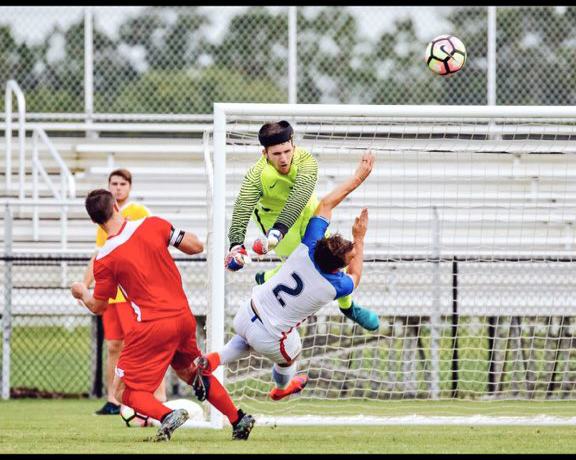Just over 20 months ago, Minnesotan Sean Boyle began recovery from a ventricular cavernous malformation (VCM) around his brain stem that left him stuck in a hospital for three months. The would-be future professional goalkeeper had just begun his college pursuit of his goalkeeping dream when his injury cut his career short. That is, until last year Boyle was brought in to represent the US for the 2016 Paralympics in Brazil.
Read my longer profile of Sean Boyle and his journey to the 2016 Paralympics here.
When we spoke last, Sean Boyle didn’t know what was next. He was off to play in the 2016 Paralympics for the United States and that feat was already overwhelming. But he had college to catch up on and the rest of his life to figure out.
A year later, I call up Sean as he trains at Barcelona’s academy in Casa Grande, Arizona. Since our last conversation, he admits he hasn’t played much soccer.
“I kind of stepped away just to focus on school. I’m 22 and still a sophomore,” he says. So he transferred to Northeastern in Boston and didn’t join up with the US Paralympic National Team (USPNT) for any camps during the year.
The USPNT is gearing up for the IFCPF CP World Championships in San Luis, Argentina that begin this week and Sean wasn’t even sure if he would be on the team. “I wasn’t planning on going to Argentina,” he admits a bit sheepishly, ” but Northeastern is giving me college credit for being on the team.”
Whatever his reasons, Boyle is rejoining his comrades and yet again making an improbable return to the pitch. When I speak to him, he’s trying to get back in shape for a tournament. And the USPNT are looking to make good after a bit of a disappointing Paralympics in Brazil, where they finished bottom of their group.
Expectations raised
Going into the 2016 Paralympics, Boyle says, the goal was to beat Holland and see where they could go from there. The Yanks earned a last gasp draw against the Dutch in that first match. However, they went on to lose their next two games against Iran and Argentina.
“The Paralympics were great, but it was a little frustrating,” he says. This time around, they’re looking for more. “The expectations are much higher,” he says, “we want the medal round.”
Each paralympic team has a variety of players whose abilities are classified. Here’s a primer for those classifications.
There’s reason for optimism, he points out: “We picked up a couple of guys. We picked up a No. 8 classification* Nick Mayhugh and he came up from the DC United academy and he’s a good division one (Radford University) player and we have three other new additions.”
And the team is starting to get results. This summer they played Canada and Chile and came away victorious (drawing and then beating Canada, then beating Chile 6-0 and 10-0). They also come into the World Championships ranked 6th in the world, their highest ranking ever.
Their path toward that medal round won’t be easy, though. The Yanks are grouped with the world champions, Ukraine, Northern Ireland (#13), and Australia (#16). Those second two teams don’t worry Boyle, but he admits that Ukraine is a tough ask.
“All three of our opponents are full time, paid programs [unlike the USPNT],” he says, “but watching film, these two are definitely beatable with the squad that we have.”
A completely normal life
Sean has never liked the word “disabled.” He shrugs it off, “I mean I have issues, but I live a completely normal life. If you see me walk down the street no one will ever know, but if you put me on the medical table you can see things.”
“You’re just an athlete. You just have to adapt your body to compete on the field. You don’t have a left leg, use your right leg to make the pass.”
Playing for the Paralympic National Team doesn’t really change that either, other than having to talk to people about his injury. “I clearly have physical issues on the field that allow me to play in the game,” he notes. “I’m not hiding anything, but on this team disability isn’t treated as an excuse.”
He means that his disability is just like another rule. Outfield players can’t use their hands in soccer, so they adjust by using their bodies differently than every day use. “You’re just an athlete,” he explains. “You just have to adapt your body to compete on the field. You don’t have a left leg, use your right leg to make the pass.”
And that disability is enough that a professional goalkeeping career is impossible, but Boyle has had plenty of time to adjust to that reality. When he returns from Argentina, Boyle will be in Atlanta for the fall semester working for Soccer in the Streets. After that, it is still up in the air. Soccer will probably be a part of it, he says. “I’d like to be working within an MLS team doing media relations or MLS Works. I want to stay attached to soccer, but in terms of community and those noble aspects.”
Sean also wanted to make a final plug for the Paralympic team. “Most people don’t know about it and we need more players.” He says that there is a large number of people with some sort of brain injury or disorder that would be eligible who just don’t know about the team. “We’re always looking for players,” he says.
For more information about the team and tryouts, please contact head coach Stuart Sharp at ssharp@ussoccer.org.
Check out this primer on the rules of Paralympic 7-a-side soccer.
FiftyFive.One is now on Patreon. Do you like the independent coverage of soccer news from Minnesota and beyond that FiftyFive.One offers? Please consider becoming a patron.

Leave a Reply